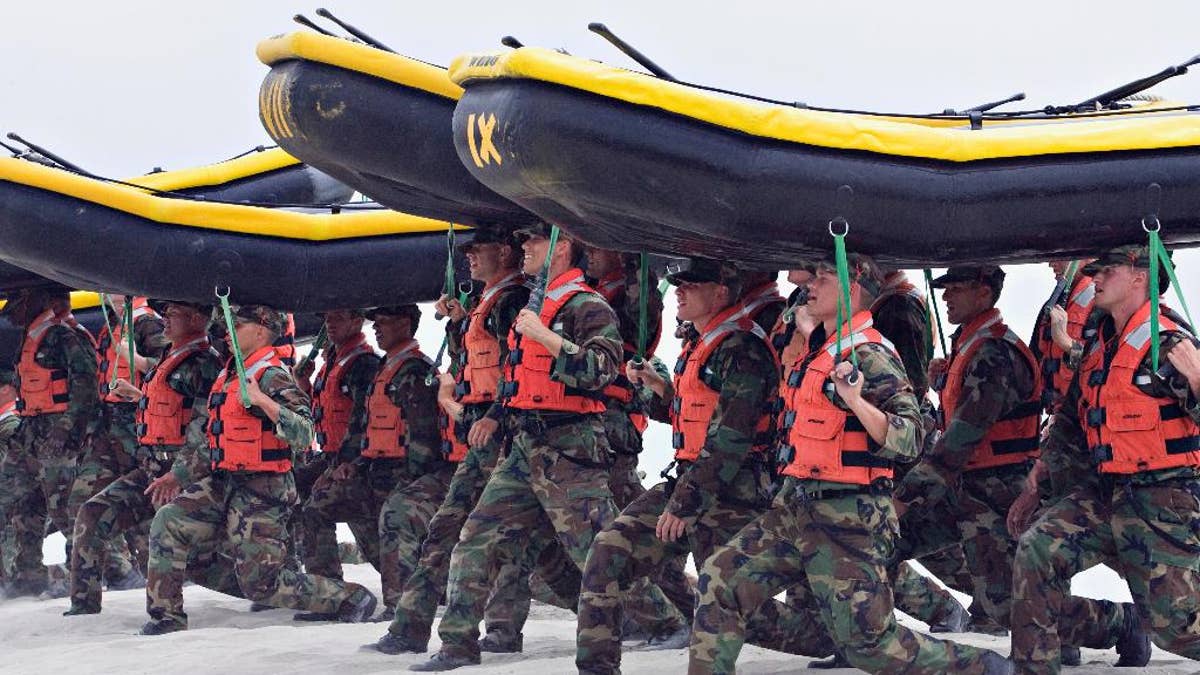
FILE - In this May 14, 2009 file photo, Navy SEAL trainees carry inflatable boats at the Naval Amphibious Base Coronado in Coronado, Calif. In a highly unusual move, the training death of an aspiring Navy SEAL, 21-year-old Seaman James Derek Lovelace, has been ruled a homicide by the San Diego County Medical Examiner. Lovelace was in his first week of training in Coronado, Calif., when he died. (AP Photo/Denis Poroy, File) (The Associated Press)
LOS ANGELES – The training death of an aspiring Navy SEAL, 21-year-old Seaman James Derek Lovelace, has been ruled a homicide by the San Diego County Medical Examiner — a highly unusual move. Lovelace, in his first week of training, was struggling to tread water in a giant pool when his instructor pushed him underwater at least twice. An autopsy found he drowned. Here's a look at the grueling six-month training program that only 25 percent of trainees on average successfully complete.
BUD/S
The training program is known as BUD/S, for Basic Underwater Demolition/SEAL training. Before it even begins, trainees go through a five-week pre-training and "indoctrination" process, according to the Navy SEALS website. Then the three-phases of harsh training begin.
PHASE 1: PHYSICAL CONDITIONING
This first and toughest of the phases, and the one in which Lovelace died, lasts eight weeks. It includes swimming up to two miles with fins in the ocean, running four miles in boots against the clock, enduring wet, cold and exhaustion in many forms and sleeping only four hours per night. The peak of the first phase is known as "Hell Week," and is the time at which many drop out of the program.
"Physical discomfort and pain will cause many to decide it isn't worth it," the SEALs website says. "The miserable wet-cold approaching hypothermia will make others quit. Sheer fatigue and sleep deprivation will cause every candidate to question his core values, motivations, limits, and everything he's made of and stands for."
PHASE 2: DIVING
The second eight-week phase focuses on underwater diving with an emphasis on fighting. The trainees do both compressed-air and 100 percent oxygen SCUBA diving, long distance underwater dives and mission-focused swimming and diving techniques. The intensity of physical training is also stepped up.
PHASE 3: LAND WARFARE
The final phase is a souped-up version of what many in the military go through in basic training. "At this point, training shifts from testing how the men react in a high-stress "gut check" environment, to making sure the trainees are competent in their core tasks," the SEALS site says. It includes weapons training and marksmanship, explosives, small unit tactics and rappelling and rope operations. If it's completed, graduation comes next and the trainees become "worthy of the sacrifices of the courageous Frogmen who came before them, and the great honor it is to serve as a U.S. Navy SEAL."





















